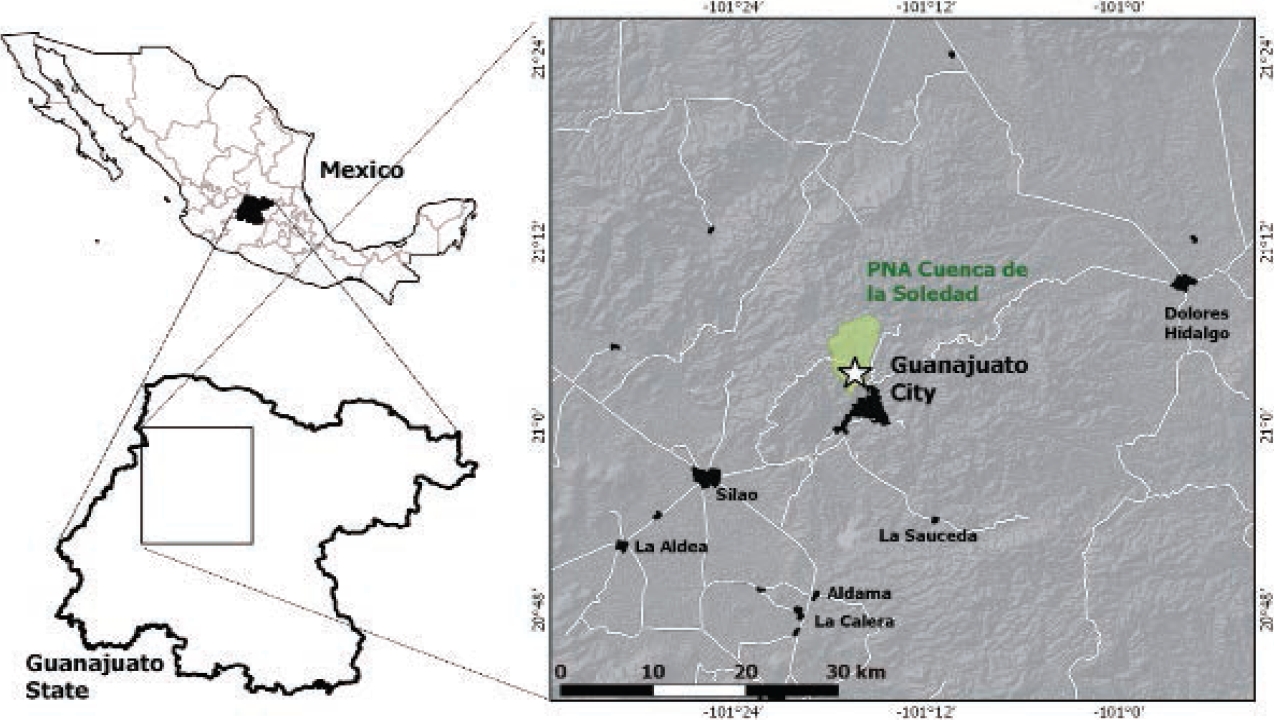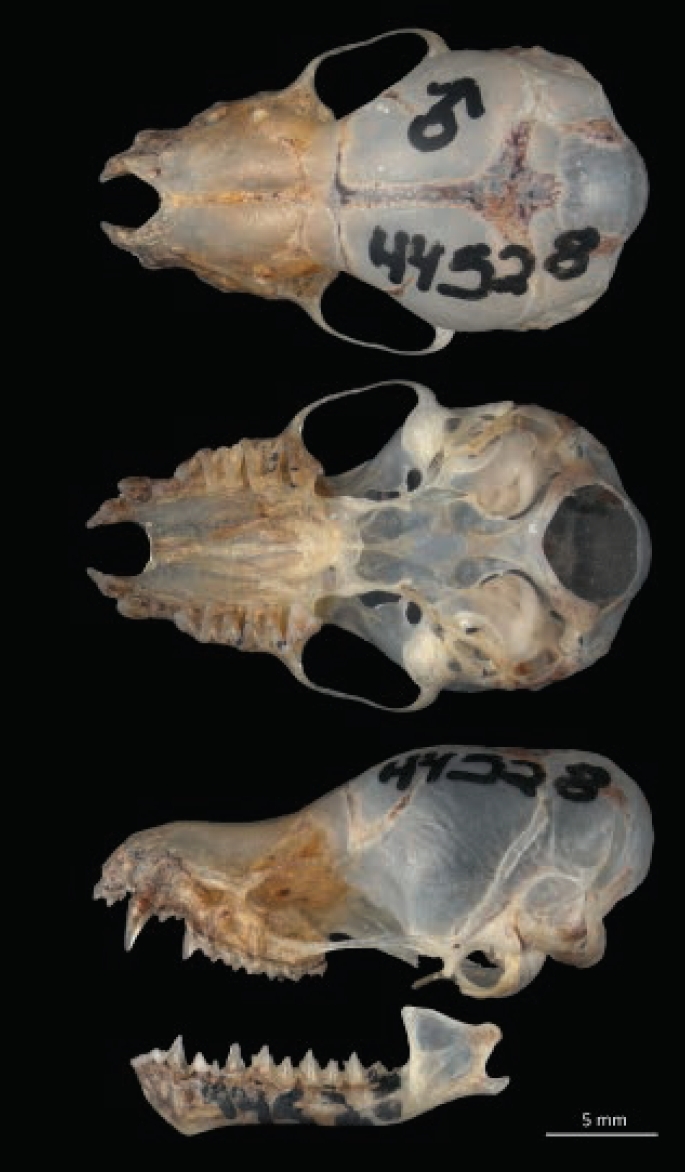Introduction
Thirty species of bats have been documented in Guanajuato (Sánchez et al. 2009; Sánchez et al. 2012; Sánchez 2014; Sánchez et al. 2016), a state located in central Mexico. However, no complete list showing the full diversity of bats in the state of Guanajuato yet exists; hence this number will undoubtedly increase as new studies are carried out in the area.
The bat, Myotis occultus (Vespertilionidae), is a small-sized vesper bat. This species differs from other species of Myotis from Guanajuato, M. thysanodes and M. velifer, for its medium size and different dorsal pelage coloration. M. thysanodes have big ears, and fringed uropatagium, whereas M. velifer has a small patch with few hairs (sometimes appearing as an almost-naked areas) in the middle part of the back, and both species have a well developed sagittal crest. M. occultus, is more similar in size to M. yumanensis, and both species lack a sagittal crest. M. occultus, has long, thick, and glossy fur on its back, which is black at the base and bright yellow at the tip (except for the ones on the base of the neck); it has large, dark brown or blackish ears with a long spear-shaped tragus, and M. yumanensis has dorsal hairs that are shorter with paler tips, pelage duller and not glossy, paler ears, and larger tragus having a semicircular border. In M. occultus, the braincase does not rise abruptly, and the middle and occipital regions are almost at the same level. In M. yumanensis the braincase rises at an abrupt angle from the rostrum, the mastoid breadth is smaller, and the calcaneum is not keeled. Dental formula of M. occultus is I 2/3, C 1/1, PM 3/3, M 3/3 = 38 (Ortega and Arita 2005; Medellín et al. 2008; Álvarez-Castañeda and Gónzalez-Ruiz 2015; Braun et al. 2015).
The species feeds on insects and migrates in winter to temperate regions (Humphrey 1982). The known distribution of M. occultus extends from the semi-arid areas of the southwestern United States down as far as the middle half of Mexico (Arroyo et al. 2008). It is a rare species with few records in Mexico, most of which have been documented in the states of Chihuahua (Anderson 1972), Zacatecas and Mexico State, as well as in Mexico City (Hall and Kelson 1959; Álvarez and Ramírez 1972; Urbano et al. 1987; Sánchez et al. 1989; Ortega and Arita 2005; Hortelano et al. 2016; Ríos-Muñoz et al. 2017).
Other studies report the presence of M. occultus in Aguascalientes (Chávez-Andrade et al. 2015) and Hidalgo (Mejenes-López et al. 2010, Ramírez-Pulido et al. 2017), but cite for this purpose other studies that are either unpublished (Aguascalientes) or report only a potential distribution within the borders of the state (Ortega and Arita 2005). In addition, a more recent checklist for Hidalgo, based on published papers, specimens in biological collections, and databases, does not include M. occultus (Sánchez-Rojas et al. 2016). Therefore, in the absence of verifiable, well-documented records, these states are not considered as part of the confirmed distribution of M. occultus.
This paper describes the first documented record in Guanajuato of the bat (Myotis occultus, Hollister 1909), based on 12 specimens caught in the locality of Llanos de Santa Ana in the municipality of Guanajuato, Mexico.
Materials and methods
Study Area. The locality of Llanos de Santa Ana is situated within the municipality of Guanajuato, Mexico, in the state of the same name. It is also located within the Protected Natural Area (PNA) of Cuenca de la Soledad, a state-level PNA classified as one requiring special attention in terms of ecological restoration, for being an important aquifer recharge area that feeds La Soledad reservoir, one of the main sources of water for the city of Guanajuato. The local vegetation corresponds to that of deserts and xeric shrublands, with a high rate of deforestation caused by the intense mining activity in the region.
On August 6, 2008, as part of a study of the bats in the area, we collected twelve specimens of M. occultus at the entrance of an abandoned mine (21° 03’ 25” N, -101° 16’ 27” W, 2,240 m.), located 4.25 km NW of Guanajuato (Figure 1), by using a 12 m x 2.5 m mist net that remained open from 18:00 h to 23:00 h. We identified individuals using keys for Mexican mammals (Medellín et al. 2008; Alvarez et al. 2015) and prepared the specimens for scientific study following the recommendations of Gannon et al. (2007). All specimens were deposited in the National Collection of Mammals (CNMA) at the Institute of Biology of the National Autonomous University of Mexico (UNAM) under catalog numbers CNMA 44523 to 44532 and 47305-47306. Prior to collecting the specimens, we first obtained the necessary permit (number FAUT-0070) from the Ministry of Environment and Natural Resources (SEMARNAT). Somatic and cranial measurements were registered following Álvarez-Castañeda and Gónzalez-Ruiz (2015).

Figure 1 Geographic location of the collection site of Myotis occultus in the Protected Natural Area (PNA) Cuenca de la Soledad, Municipality of Guanajuato, Gto., Mexico.
We obtained Cytochrome Oxidase I (COI) gene sequences for five of the specimens collected, CNMA 44523- 44527 (GU686195, GU686214, GU686212, GU686213, GU686193, respectively), which are available on the BOLD Systems website and GenBank for future studies but they were not used to corroborate the identity of the specimens.
Results
The twelve specimens collected were reproductively inactive males. The range and average external measurements (in mm) of these individuals were: total length (TL): 71 - 84, = 79.95; length of tail (LT): 30 - 38, = 34.5; length of hind foot (LHF): 6 - 14, = 9.58; length of ear (LE): 11 - 14, = 13.4; and length of forearm (LF: 31 - 36, = 33.5; Figure 2). The average cranial and mandibular measurements were: length of skull (LS): 13.70 - 14.34, = 13.98; cranial width (CW): 6.86 - 7.60, = 7.12; cranial height (CH): 5.96 - 6.58, = 6.17; zygomatic breadth (ZB): 7.72 - 8.28, = 8.06; mastoid breadth (MB): 6.08 - 7.06, = 6.94; interorbital breadth (IOB): 3.62 - 3.96, = 3.79; breadth across upper molars (BAM): 5.20 - 5.24, = 5.13; maxillary toothrow length (MAX): 5.09 - 6.01, = 5.78; condylobasal length (CBL): 11.25 - 12.00, = 11.70; and mandibular toothrow length (MAN: 6.26 - 6.58, = 6.44; Figure 3).

Figure 2 A specimen of Myotis occultus collected in the Protected Natural Area (PNA) of Cuenca de la Soledad, Guanajuato, Mexico (Photo Y. Hortelano).
Discussion and Conclusions
The presence of M. occultus in the state of Guanajuato is consistent with the potential distribution of the species (Ortega and Arita 2005). Therefore, this is the first record of M. occultus for the state supported with voucher specimens. In addition, we uploaded DNA sequences at GenBank for further studies.
Until now, the list of bats in the state of Guanajuato includes 30 species (Sánchez et al. 2016). However, this figure is still somehow low compared to that of areas that have undergone major urban development such as the Mexico City Metropolitan Area, where 28 species have been described (Sánchez et al. 1989; Hortelano-Moncada et al. 2016). Furthermore, the state of Guanajuato encompasses portions of two biogeographic regions: the Neartic and the Neotropical, in an area where the Sierra Madre Oriental, the Trans-Mexican Volcanic Belt, and the Mesa Central come together, a situation that provides a noteworthy diversity. We suggest that more exploration studies be done to obtain a better approximation of its biological diversity.











 nueva página del texto (beta)
nueva página del texto (beta)



